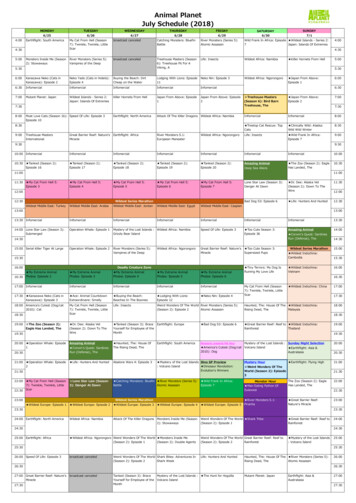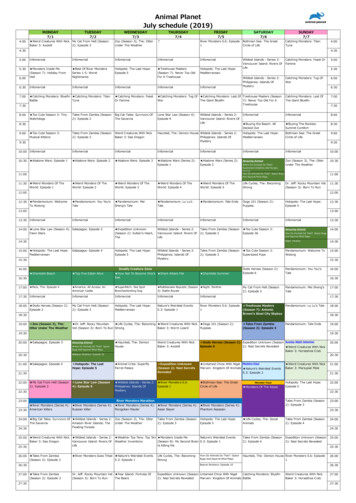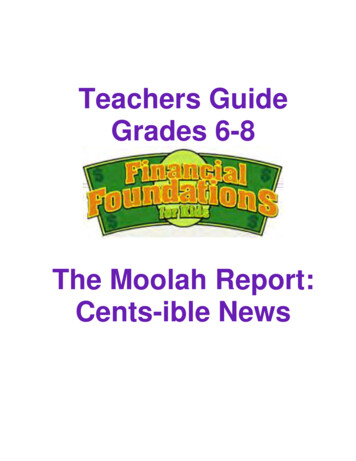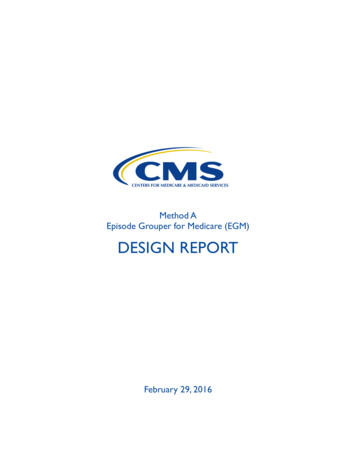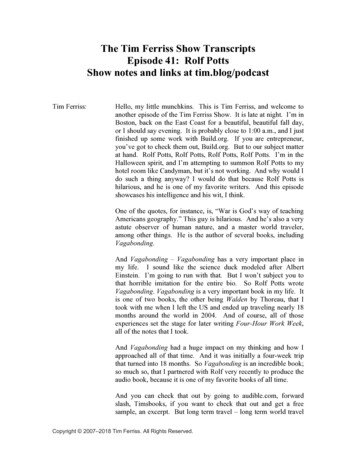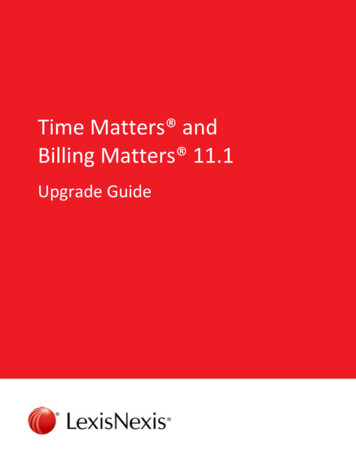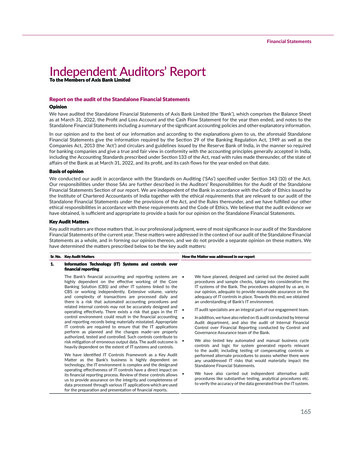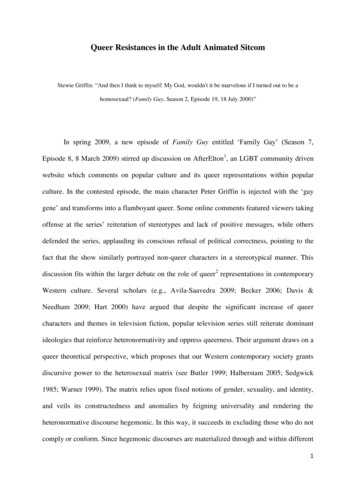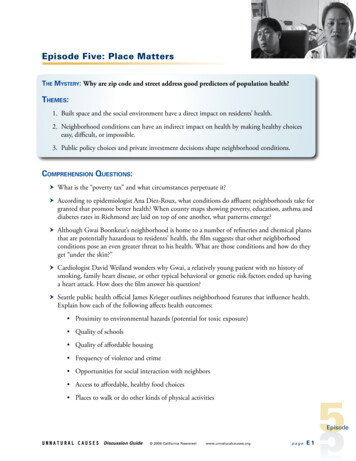
Transcription
Episode Five: Place MattersThe Mystery: Why are zip code and street address good predictors of population health?Themes:1. Built space and the social environment have a direct impact on residents’ health.2. Neighborhood conditions can have an indirect impact on health by making healthy choiceseasy, difficult, or impossible.3. Public policy choices and private investment decisions shape neighborhood conditions.Comprehension Questions: What is the “poverty tax” and what circumstances perpetuate it? According to epidemiologist Ana Diez-Roux, what conditions do affluent neighborhoods take forgranted that promote better health? When county maps showing poverty, education, asthma anddiabetes rates in Richmond are laid on top of one another, what patterns emerge? Although Gwai Boonkeut’s neighborhood is home to a number of refineries and chemical plantsthat are potentially hazardous to residents’ health, the film suggests that other neighborhoodconditions pose an even greater threat to his health. What are those conditions and how do theyget “under the skin?” Cardiologist David Weiland wonders why Gwai, a relatively young patient with no history ofsmoking, family heart disease, or other typical behavioral or genetic risk factors ended up havinga heart attack. How does the film answer his question? Seattle public health official James Krieger outlines neighborhood features that influence health.Explain how each of the following affects health outcomes: Proximity to environmental hazards (potential for toxic exposure) Quality of schools Quality of affordable housing Frequency of violence and crime Opportunities for social interaction with neighbors Access to affordable, healthy food choices Places to walk or do other kinds of physical activitiesEpisodeUnnatural C auses Discussion Guide 2008 California depageE1Episode
After World War II, many white residents left Richmond. Whatconditions prevented African Americans from leaving as well?Describe the “cycle of disinvestment” that followed, and provideexamples from the film of how community-based organizationsin Richmond are working today to promote health equity. Tom Phillips, Seattle Housing Authority, says: “Even thoughthis was a rough, dangerous neighborhood, there was still acommunity here and people living in communities actually knowwhat they want.” How was High Point able to rebuild? What wasthe involvement of residents, community groups, housing andhealth officials, government agencies and private investors? Whathappened to the residents of Old High Point?Discussion Questions: What health threats does Gwai face that are beyond hisindividual control? How do neighborhood conditions, his joband income situation and being an immigrant affect his abilityto keep his children out of harm’s way? How might all of thisaffect Gwai’s stress level? What options would make thingsbetter for Gwai’s family and others? What health advantages do residents of wealthier neighborhoodshave that are often lacking in neighborhoods like where Gwailives? Why do these differences exist? Dr. David Williams argues that health campaigns focused solelyon changing individual behavior are naïve because “the choicesof individuals are often limited by the environments in whichthey live.” How does your neighborhood limit or expandhealthy choices? What would you like to see improved in yourneighborhood? What will it take to make that happen? Epidemiologist Ana Diez-Roux observes that neighborhooddifferences are not “natural.” What draws businesses and investment to some places andnot others? What kinds of state or national policies can help revitalizeneighborhoods? What lessons from the example of High Point can beapplied to the neighborhood where you live? How can youreplicate the partnerships, creative financing and healthinnovations that made High Point work?EpisodeUnnatural C auses Discussion Guide 2008 California depageE2Episode
The film states that the health problems of Southeast Asian refugee communitiesare often masked by including them under the aggregated label “AsianAmerican.” Would a color-blind approach to health problems make theseproblems easier or harder to solve? What demographic categories should we usefor gathering health data? The documentary touches upon the health effects of violence in Richmond. Inwhat ways does violence affect the health of children? If violence is presented asa public health threat rather than a crime issue, how might that affect the waypolicy changes are perceived? The documentary asks, “How do you make an unhealthy neighborhood healthy?” What makes a neighborhood unhealthy to begin with? What are the challenges involved in trying to improve neighborhoodconditions? How can a disinvested community be revitalized without triggering theincreases in rent and home prices that displace poorer residents and leadto gentrification? Dr. Tim Takaro says, “Market driven forces are not going to build healthyhomes for low-income communities.” Why not? What forces have shaped yourcommunity in the past? How were decisions made? Who was left out? If themarket doesn’t support the creation of healthy, affordable homes for people whoneed them, how can we change the market or create non-market solutions? At the end of the film, David Williams says. “Housing policy is health policy,educational policy is health policy, anti-violence policy is health policy,neighborhood improvement policies are health policies. Everything that we cando to improve the quality of life of individuals in our society has an impact ontheir health and is a health policy.” How can we better ensure that all of us, notjust the wealthy, have the conditions for good health? How will decision makinghave to change?Suggested Activity: Neighborhood Assessment1. Consider your own neighborhood (or a neighborhood selected by the group).Answer the questions below: What does this neighborhood look like? What are the strengths of this neighborhood? What actions could be taken to sustain those strengths? Who can help us take those actions?EpisodeUnnatural C auses Discussion Guide 2008 California depageE3Episode
What things in this neighborhood need to be improved to reduce chronicstress, give residents better access to healthy choices, and/or give people agreater control over their lives? Be as specific as possible. What actions could be taken to make those improvements? Who can help us take those actions?2. Pick at least one item from the list and define a few concrete action stepstoward change.Web Site Tips:Online Activity: Explore what differentiates a healthy neighborhood from an unhealthyone in A Perfect Neighborhood.Online Activity: A Tale of Two Smokers follows two people trying to live a healthierlife - see how outside factors affect their ability to succeed.Key References:Asian Pacific Environmental Network (APEN) - www.apen4ej.orgBell, Judith and Victor Rubin. Why Place Matters: Building a Movement for HealthyCommunities. Oakland, CA: PolicyLink, 2007. sreport web.pdfBuilding Stronger Communities for Better Health. Washington, DC: Joint Center forPolitical and Economic Studies Health Policy Institute, May 2005.www.jointcenter.org/publications recent publications/health/building strongercommunities for better healthBullard, Robert, Paul Mohai, Robin Saha, and Beverly Wright. Toxic Wastes and Race atTwenty. United Church of Christ Justice and Witness Ministries, March 2007.www.ejnet.org/ej/twart.pdfThe Contra Costa County Health Disparities Initiative - www.cchealth.org/groups/rhdiDiez-Roux, Ana. “Neighborhood of Residence and Incidence of Coronary HeartDisease,” New England Journal of Medicine, 345 (July 2001): 2.Iton, Anthony. “Tackling the Root Causes of Health Disparities through CommunityCapacity Building.” Tackling Health Inequities through Public Health Practice: AHandbook for Action ed. Richard Hofrichter. Washington, DC: National Association ofCounty and City Health Officials, 2006: 115-136. www.naccho.org/pubs/product1.cfm?Product ID 11EpisodeUnnatural C auses Discussion Guide 2008 California depageE4Episode
Krieger, James E., Tim K. Takaro, Lin Song, and Marcia Weaver.“The Seattle-King County Healthy Homes Project: A Randomized,Controlled Trial of a Community Health Worker Intervention toDecrease Exposure to Indoor Asthma Triggers,” American Journal ofPublic Health, 95 (April 2005): 4.The National Low Income Housing Coalition: www.nlihc.orgPastor, Manuel Jr., Rachel Morello-Frosch, and James Sadd. Still Toxicafter All These Years. The Center for Justice, Tolerance, & Communityat the University of California Santa Cruz, February 2007. Available at:http://cjtc.ucsc.edu/pub reports.htmlA Place for Healthier Living: Improving Access to Physical Activity andHealthy Foods. Washington, DC: Joint Center for Political and EconomicStudies Health Policy Institute, June 2004. http://www.jointcenter.org/publications recent publications/health/a place for healthier livingimproving access to physical activity and healthy foodsTHRIVE: The Tool for Health and Resilience in VulnerableEnvironments. Oakland, CA: Prevention .phpFrom the film: Of 350,000 federally guaranteed new home loans madebetween 1946 and 1960 in Northern California, less than100 went to black families. Of 120 billion in governmentbacked home loans nationally between 1934 and 1962, lessthat two percent went to non-white households. In Seattle, the typical cost of emergency room visits for achild with asthma living in a disadvantaged neighborhood is 3,000- 5,000/year. According to University of Michigan epidemiologistAna Diez-Roux, living in an economically disadvantagedcommunity can increase the risk of heart disease by as muchas 80%. In Boston, children living in economically disadvantagedneighborhoods are six times more likely to be hospitalized forasthma than children in neighborhoods at the high end of theeconomic spectrum.EpisodeUnnatural C auses Discussion Guide 2008 California depageE5Episode
child with asthma living in a disadvantaged neighborhood is 3,000- 5,000/year. According to University of Michigan epidemiologist Ana Diez-Roux, living in an economically disadvantaged community can increase the risk of heart disease by as much as 80%. In Boston, children living in economically disadvantaged

